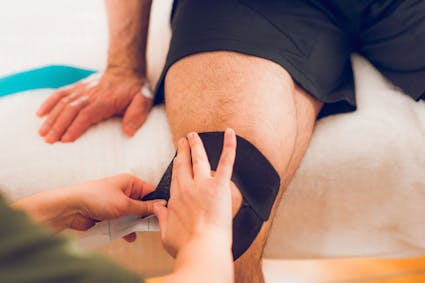
Kinesio® Tape was invented by Japanese chiropractor, Dr. Kenzo Kase, in 1979, as a result of much research in kinesiology, the science behind muscular and skeletal movement. Dr. Kase developed both the method and the first elastic therapeutic tape, Kinesio Tape. He also founded Kinesio, the company behind the product, in the 1980s, and formed the Kinesio Taping Association (KTA) in 1984. Kinesio USA, LLC, began operating in 1994, headquartered in Albuquerque, New Mexico.
Kinesio® Tape is a latex-free, elastic porous cotton strip with an acrylic adhesive used for treating athletic injuries and a variety of other physical disorders. Kinesio® Tape stretches up to 140% of its original length, which allows much greater range of motion, compared to traditional white athletic tape. It can also be left on for longer periods of time (up to 4 days) before reapplication is needed. Kinesio® Tape is about as thick as human epidermis (skin) and is designed to mimic its elastic properties to alleviate pain, reduce inflammation, relax muscles, enhance performance, and help with rehabilitation as well as supporting muscles during a sporting event.
The Kinesio Taping® (KT) Method is the rehabilitative application of Kinesio® Tape to facilitate the body's natural healing process while providing support and stability to muscles and joints without restricting the body's range of motion as well as providing extended soft tissue manipulation to prolong the benefits of manual therapy administered within the clinical setting.
According to Dr. Kaze, the four major functions of Kinesio Taping® are:
- Supporting the muscle: Proper taping improves the muscle's ability to contract even when it's weakened, reduces a feeling of pain and fatigue, and protects the muscle from cramping, over-extension and over-contraction.
- Removing congestion to the flow of body fluids: Kinesiology tape improves blood and lymphatic circulation and reduces inflammation and excess chemical buildup in the tissue.
- Activating the endogenous analgesic system: "Endogenous" refers to something that is self-originating, and calling something "analgesic" means that it can relieve pain in a conscious person. So, this requirement means that the tape must facilitate the body's own healing mechanisms, a central focus in chiropractic medicine.
- Correcting joint problems: The goal is improving range of motion and adjusting misalignments that result from tightened muscles.
These four functions drive the technology behind the tape, which features a very thin, highly elastic porous cotton top side, that lets the skin breathe and an underside of sticky water-repellant, medical-grade acrylic adhesive, which further supports the muscles and connective tissues. By targeting different receptors within the somatosensory system, Kinesio® Tape alleviates pain and facilitates lymphatic drainage by microscopically lifting the skin, which reduces swelling and inflammation. Kinesio® Tape can be applied in hundreds of ways and has the ability to re-educate the neuromuscular system, reduce pain and inflammation, enhance performance, prevent injury and promote good circulation and healing, and assist in returning the body to homeostasis (internal conditions remain stable and relatively constant).
